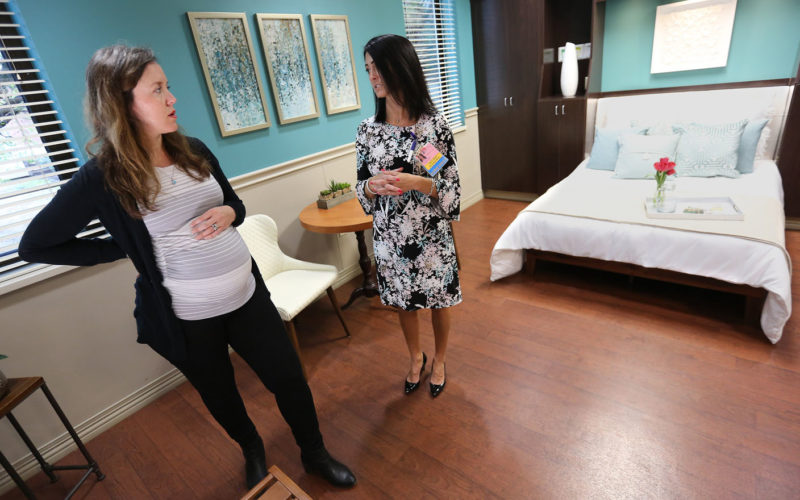Childbirth options evolve in Northwest Arkansas
ALEX GOLDEN
agolden@nwadg.com

The Free Weekly/DAVID GOTTSCHALK
The labor tub is inside the low-intervention birthing suite at Willow Creek Women’s Hospital in Johnson.
Sarah West Castle learned several months into her pregnancy her birthing plan was no longer an option.
The 32-year-old Van Buren woman had a baby in 2016 at the Birth Center of Northwest Arkansas in Rogers and was planning on going there again with her second child in late December or early January.
“I was devastated. I broke down crying,” Castle said about when she got the phone call the center would be closing in December.
Birthing centers are facilities where women give birth naturally, typically with a midwife. Unlike a hospital, there’s no medically induced labor, no Cesarean sections and no epidurals. Also, unlike a hospital, women are generally encouraged to give birth in whatever position feels natural to them and offered alternative options, such as water births.
Northwest Health recently opened low-intervention suites at its Bentonville hospital and its Willow Creek Women’s Hospital in Johnson. The low-intervention suites are to offer a similar experience to a birthing center. They opened partly in response to the only birthing center in Northwest Arkansas closing and because a number of patients were interested in low-intervention births, officials said.
“People underestimate how wanted this is,” said Kelsey Gilley, a nurse midwife who worked for the birth center. “At the birth center, patients from Little Rock, Oklahoma, Missouri, came to us because they couldn’t get anything like that.”
Gilley is a nurse midwife who will care for patients in the low-intervention suites at Northwest Health.

The Free Weekly/DAVID GOTTSCHALK
Erin Killeen (center) visits with Christine Picarelli (left) and Samantha Corral (right), certified nurse midwife and doctor of nursing practice, at Willow Creek Women’s Hospital in Johnson.
Another option
Castle said she didn’t want a home birth or a hospital birth. She liked that the Birthing Center had little intervention in her birth, but she could be taken to a hospital quickly if something went wrong. Castle said she didn’t feel rushed, and the room was more like home than a typical hospital room.
Some women did water births at the center, and Castle started in the tub while she was in labor but ultimately decided to give birth in the bed.
“I just felt so relaxed,” she said.
A representative from the Birth Center of Northwest Arkansas didn’t return phone calls. A news release said the center closed for financial reasons.
The low-intervention suites at Northwest Health and Willow Creek have beds larger and lower to the floor than hospital beds, tubs for hydrotherapy for pain relief, wireless monitoring so patients can walk around and stools designed for patients who want to give birth upright. Patients may also use nitrous oxide for pain relief, said Juli cqMcWhortercq, chief administrative officer at Willow Creek.
“Most of all, it allows ladies to have the sort of birth experience that they want to have,” said Steve Badgercq, chief executive officer at Northwest Health-Bentonville.
The idea is for women who want an at-home experience to have the option of doing something similar, but in a hospital where they have more safety measures, he said.
“The hope is that they’ll come into a low-intervention birthing suite and not feel like they’re in a hospital at all,” said Samantha Corralcq, a nurse midwife at Willow Creek. “The idea is to promote a very calm and home-like environment. … Labors, as we know, go the most smoothly when patients feel safe and comfortable and where they don’t feel like they’re up in arms.”
Although women typically give birth in a hospital while on their backs, that’s often not the best way, Gilley said.
“Left to their own devices, women will kind of tell you which position they need to be in to birth, maybe not verbally, but their body will just do that position,” she said.
Being in an upright position can help because gravity is on their side, she said.
Not for everyone
State law bans birth centers from taking patients who fall into any of 21 high risk categories. Patients who have heart disease or another serious health condition, are younger than 14 or are giving birth to twins or a premature baby, for example, wouldn’t be able to deliver at a birthing center.
Likewise, licensed lay midwives are only allowed to care for healthy women, “determined through a physical assessment and review of the woman’s health and obstetric history, who are at low risk for the development of medical or obstetric complications of pregnancy or childbirth and whose expected outcome is the delivery of a healthy newborn and an intact placenta,” according to the Health Department.
A licensed lay midwife isn’t a certified nurse midwife. Gilley and Corral, both certified nurse midwives, are licensed in midwifery and are also nurse practitioners who can do annual gynecological exams, prescribe birth control and some other medications and provide prenatal care for patients.
“As a rule of thumb, midwives take care of healthy, low-risk individuals,” Gilley said.
Gilley said anything considered too risky for a birth center would also be too risky for a low-intervention suite.
“I believe in physicians, too,” Corral said. “We work with them, and we love them.”
A number of complications can happen unexpectedly during childbirth that are dangerous to deal with at home, McWhorter said.
“It’s a danger to both the mom and the baby, and those occur very rapidly,” Badger said. “Unfortunately, we’ve had tragedies come to our doorstep because of that.”
In 2016, four babies in Arkansas were taken to hospitals after they were born at home under the care of a licensed lay midwife. Thirty-eight women attempted to give birth at home with a licensed lay midwife but ended up being taken to hospitals during labor, according to the Health Department.
Why another way?
Women have different reasons for going an alternate route.
“I feel like I see a lot of really educated women who are doing research and reading studies, and they’re hearing about other options from other states, from universities, and once they’ve heard that there’s another way, they’re seeking out ways to do that in Northwest Arkansas,” Corral said.
Cindy Ramirezcq, 30, of Rogers, said giving birth naturally was a personal goal of hers.
“I wanted to see if I could truly go through the process,” she said.
Ramirez said she had a good experience and the staff seemed focused on making her comfortable when she gave birth last month in one of the low-intervention suites.
Patients who deliver with a midwife with minimal intervention also save on health care costs, Corral said.
Arkansas Blue Cross Blue Shield covers births at some birthing centers but not home births, said Max Greenwood, spokeswoman.
An uncomplicated vaginal birth averages $8,000, according to Fair Health, an independent national nonprofit organization compiling data from healthcare claims.
Carol Sakalacq, who leads maternal health and maternity care for the National Partnerships for Women and Families, a Washington-based organization, said women often don’t get respectful care while they are in labor at hospital.
“We are strong advocates of midwifery,” Sakala said.
Hospitals tend to use a blanket model for how they deliver babies, rather than adapting to individual preferences, she said. For example, a doctor may only agree to deliver a baby if the mom is on her back.
While patients have the right to refuse care, doctors also have rights and cannot be forced to do something they feel is unsafe, such as delivering a baby vaginally when the doctor deems a Cesarean section necessary, she said.
In rare cases, women have been forced to undergo Cesarean sections, Sakala said.
At hospitals, “things are organized for the ease and safety for the doctor, for the nursing staff and maybe secondarily for the patient,” Badger said.
Erin Killeencq, 32, of Fayetteville expects to give birth in May to her first child at one of the low-intervention suites.
“I think [doctors] have an extremely important role for complications, but with a natural, healthy birth, there’s not necessarily that need, and, at times the interventions can be pushed to accelerate a birth, so I really wanted to be aware of that and make sure that I wasn’t setting myself up for someone accelerating my birth,” she said.
Killeen said she liked the idea of having a nurse practitioner who would support her in a low-intervention birth but could identify when a doctor may need to intervene. She added she didn’t want to be forced to give birth on her back and she wanted the option to move around, dim the lights and have music.
More women are veering away from hospital settings.
In 2016, 335 women in Arkansas received care from a licensed lay midwife during their pregnancy, although not all of them necessarily gave birth with a midwife at home, according to the Arkansas Department of Health. That number is more than double from 10 years earlier, when 145 women received care from a licensed lay midwife.
Licensed lay midwives delivered 250 babies in homes in Arkansas in 2016, according to the Health Department. That’s an increase from 121 babies in 2006.
In 2006, 39,768 babies were born in the state, meaning about a third of 1 percent of all babies were born at home with a licensed lay midwife, according to the Health Department. In 2016, 36,953 babies were born in the state, meaning about two-thirds of 1 percent of all babies were born at home with a licensed lay midwife.
__
Birth Centers
The Arkansas Department of Health has no pending applications for freestanding birth centers, according to Meg Mirivelcq, spokeswoman for Arkansas Department of Health.
— Source: Staff report






